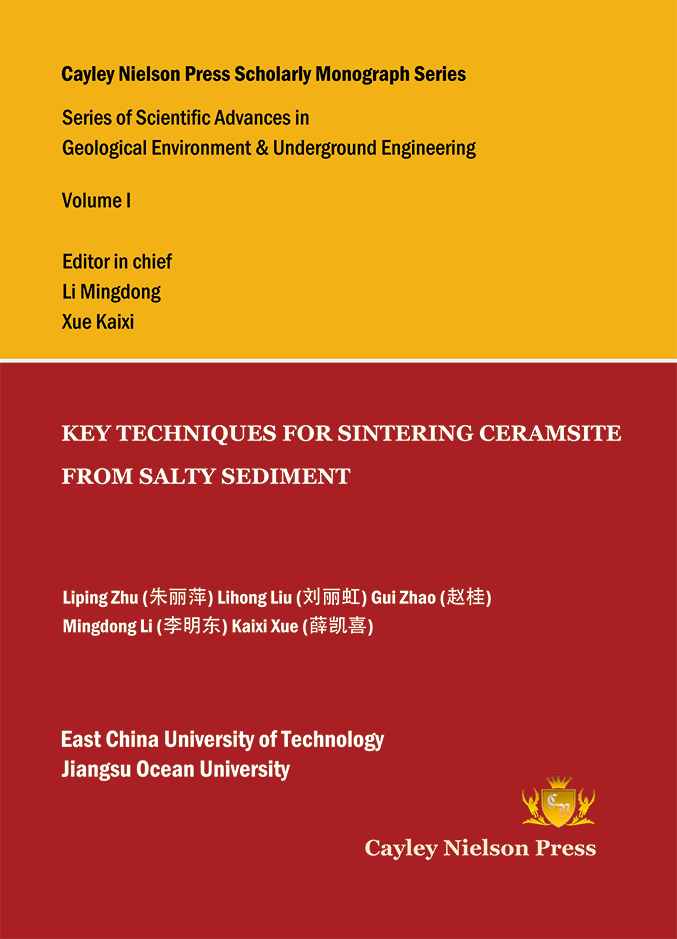
KEY TECHNIQUES FOR SINTERING CERAMSITE FROM SALTY SEDIMENT

KEY TECHNIQUES FOR SINTERING CERAMSITE FROM SALTY SEDIMENT
Liping Zhu (朱丽萍) Lihong Liu (刘丽虹) Gui Zhao (赵桂) Mingdong Li (李明东) Kaixi Xue (薛凯喜)
East China University of Technology
Jiangsu Ocean University
Copyright © 2022 by Cayley Nielson Press, Inc.
ISBN: 978-1-957274-05-8
Cayley Nielson Press Scholarly Monograph Series Book Code No.: 212-4-4
Series of Scientific Advances in Geological Environment & Underground Engineering, Volume I
Editor in chief: Li, Mingdong and Xue, Kaixi(李明东,薛凯喜)
Editors: Yi, Jinxiang; Zhang, Jingwu; Zhu, Liping; Yang, Ting; Xu, Tao; Wang, Shengfu; Shan, Lingzhi; Wan, Yukuai (易进翔,张京伍,朱丽萍,杨婷,许涛,王升福,单凌志,万愉快)
US$150.00
Contents
Chapter 1 Introduction 1
1.1 Research Background 1
1.2 Status of Waste Sediment Disposal and Resource Utilization 6
1.2.1 Current Status of Salt-bearing Sediment Disposal and Recycling 6
1.2.2 Sludge disposal and recycling technology 8
1.3 Research status of ceramsite 13
1.4 Development status of new wall materials 17
1.5 Research content and significance 19
1.5.1 Problems still exist in the sintered swelled ceramsite of salty sediment 19
1.5.2 Research ideas 20
1.5.3 Main research contents 21
1.5.4 Key technology 23
1.5.5 Significance 25
1.6 Chapter summary 26
Chapter 2 Lianyungang Sediment Characteristics and Swelling Feasibility 27
2.1 Sediment sampling 27
2.2 Methods for the determination of sediment properties 31
2.3 Chemical Characteristics of Sediment 37
2.3.1 Chemical composition of sediment 37
2.3.2 Mineral composition of sediment 38
2.3.3 Chlorine content of sediment 42
2.3.4 Thermogravimetric Analysis of Sediment 43
2.4 Physical characteristics of sediment 43
2.4.1 Particle size distribution 43
2.4.2 Liquid plastic limit 53
2.4.3 Natural drying performance of sediment 55
2.5 Feasibility of Sediment Sintering Ceramsite 57
2.5.1 Chemical feasibility 58
2.5.2 Physical feasibility 64
2.5.3 Sintering advice 69
2.6 Chapter summary 71
Chapter 3 Research on the Technology of Swelling Ceramsite for Salty Sediment 73
3.1 Research method of swelled ceramsite technology 73
3.1.1 Experiment material 73
3.1.2 Experiment procedure 76
3.2 Sintering results of pure sediment ceramsite 81
3.3 Selection of admixtures, additives and process parameters 84
3.3.1 Additive 84
3.3.2 Influence and optimization of roasting process parameters 88
3.4 Laboratory test research on the optimization of admixtures and technical parameters 89
3.4.1 Single factor test 89
3.4.2 Orthogonal test research 99
3.5 Chapter summary 101
Chapter 4 Research on the Properties of Swelling Ceramsites in Salt-Containing sediment 103
4.1 Performance index and test method of ceramsite 103
4.1.1 Bulk density 103
4.1.2 Water absorption 103
4.1.3 Strength 104
4.1.4 Soluble salt content 105
4.1.5 Total phosphorus adsorption effect 105
4.2 Laboratory test on properties of swelled ceramsite 109
4.2.1 Physical and mechanical properties 109
4.2.2 Soluble salt content 110
4.2.3 Total phosphorus adsorption performance 110
4.3 Research on properties of swelled ceramsite in pilot production test 117
4.3.1 Overall process and sintering process 121
4.3.2 Production test results and conclusions 124
4.4 Chapter summary 128
Chapter 5 Research on the Influence of Sediment Salt and Countermeasures 129
5.1 Change process and mechanism analysis of salty sediment sintering 129
5.1.1 Physical Change and Mechanism Analysis During Sintering 129
5.1.2 The change process of soluble salt content 130
5.1.3 Changes in chlorine content 133
5.1.4 The transfer and transformation mechanism of sodium chloride 134
5.2 Pre-salt removal technology for salt sediment - 136 -
5.2.1 Analysis of Sediment Dewatering and Desalting Technology - 136 -
5.2.2 Drying and washing technology - 137 -
5.2.3 Centrifugal dehydration technology - 142 -
5.2.4 High pressure dialysis technology - 147 -
5.3 Post-demineralization technology of swelled ceramsite from salty sediment - 153 -
5.3.1 Technical Principles and Features - 153 -
5.3.2 Implementation - 155 -
5.4 Chapter summary - 156 -
Chapter 6 Research on the Promotion of Industrialization of Sediment Ceramsite - 158 -
6.1 The application prospect of ceramsite - 158 -
6.2 Engineering and environmental protection significance of sediment ceramsite - 160 -
6.3 Policy Guidance - 161 -
6.4 Sediment ceramsite promotion production technology - 164 -
6.4.1 Policies to encourage technology and requirements for enterprises - 164 -
6.4.2 Sintered expanded ceramsite production line equipment - ceramsite kiln (rotary kiln) - 166 -
6.5 Promotion plan of sediment sintered ceramsite in Lianyungang City - 170 -
6.5.1 Sediment production and supply analysis of sintered ceramsite raw materials - 170 -
6.5.2 Lianyungang master plan - 171 -
6.5.3 Factory site selection analysis - 174 -
6.5.4 Enterprise needs - 177 -
6.6 Chapter summary - 177 -
Chapter 7 Conclusion - 179 -
References - 185 -
Attachment. Relevant Test Report - 191 -
(1) X-ray powder diffraction results - 191 -
(2) Quantitative Analysis Results of X-ray Powder Diffraction Detection - 193 -
(3) Sediment ablation amount - 194 -
Readership
This book should be useful for students, scientists, engineers and professionals working in the areas of optoelectronic packaging, photonic devices, semiconductor technology, materials science, polymer science, electrical and electronics engineering. This book could be used for one semester course on adhesives for photonics packaging designed for both undergraduate and graduate engineering students.
